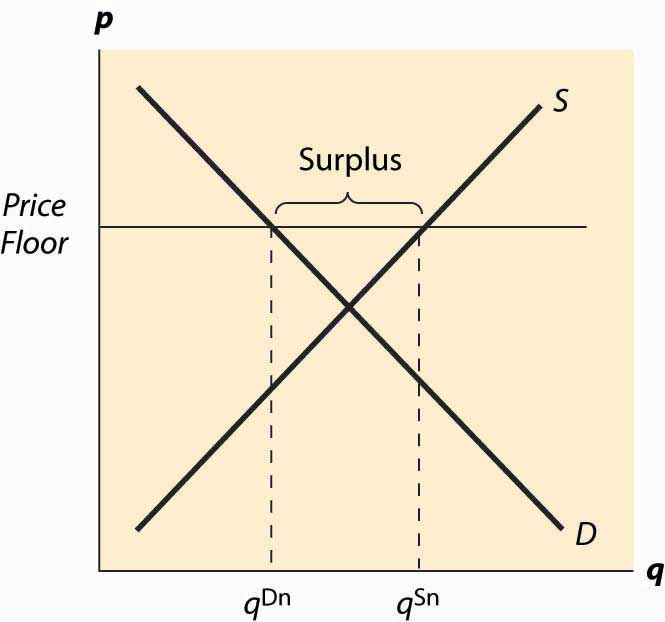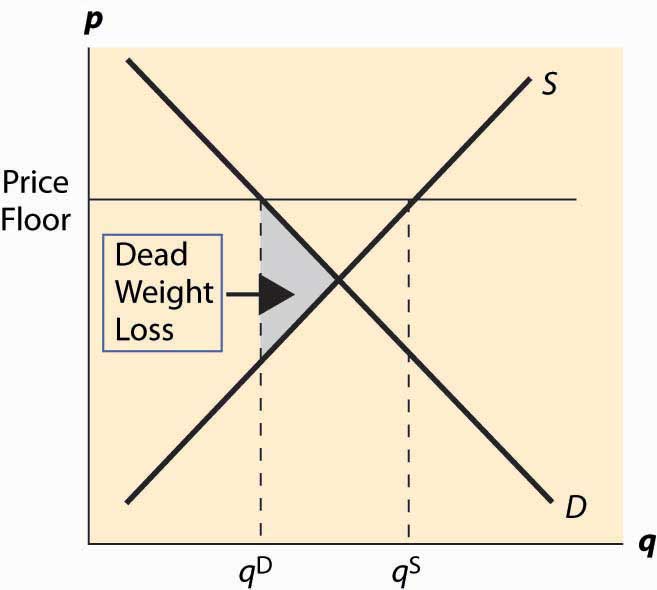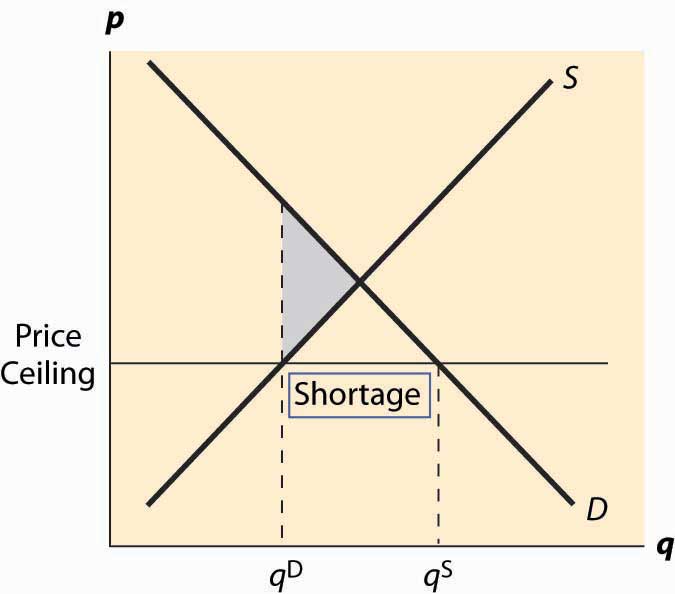What Would Happen If Suppliers Charge Less Than The Equilibrium Price For Your Good Or Service
5.4 Price Floors and Ceilings
Learning Objective
- What happens when the government, not a market, sets the toll?
A price flooringThe minimum price at which a product or service is permitted to sell. is a minimum cost at which a production or service is permitted to sell. Many agronomical goods have price floors imposed by the authorities. For example, tobacco sold in the United states has historically been subject to a quota and a price floor set past the Secretary of Agriculture. Unions may impose toll floors as well. For instance, the Screen Actors Guild (SAG) imposes minimum rates for guild members, by and large pushing up the cost paid for actors to a higher place what would prevail in an unconstrained market. (The wages of big-name stars aren't generally afflicted by SAG because these are individually negotiated.) The nigh of import example of a price floor is the minimum wageThe minimum amount that a worker can be paid per hour. , which imposes a minimum corporeality that a worker can be paid per 60 minutes.
A cost ceilingThe maximum cost that tin be charged for a product or service. is a maximum price that can be charged for a product or service. Rent control imposes a maximum price on apartments (commonly set at the historical price plus an aligning for inflation) in many U.S. cities. Taxi fares in New York, Washington, DC, and other cities are subject to maximum legal fares. During World State of war 2, and again in the 1970s, the United States imposed toll controls to limit inflation, imposing a maximum price for the legal sale of many goods and services. For a long fourth dimension, nigh U.Due south. states limited the legal interest charge per unit that could be charged (these are called usury lawsLaws that limit the legal interest rate that tin be charged. ), and this is the reason why then many credit card companies are located in Southward Dakota. Southward Dakota was the first state to eliminate such laws. In addition, ticket prices for concerts and sporting events are frequently set beneath the equilibrium price. Laws prohibiting scalping then impose a price ceiling. Laws preventing scalping are commonly remarkably ineffective in practice, of course.
The theory of price floors and ceilings is readily articulated with elementary supply and demand analysis. Consider a price flooring—a minimum legal cost. If the toll floor is depression plenty—below the equilibrium cost—there are no effects because the aforementioned forces that tend to induce a cost equal to the equilibrium price continue to operate. If the price floor is higher than the equilibrium toll, there will be a surplus because, at the price floor, more units are supplied than are demanded. This surplus is illustrated in Figure 5.5 "A price floor".
In Figure v.v "A price floor", the price floor is illustrated with a horizontal line and is above the equilibrium cost. Consequently, at the cost floor, a larger quantity is supplied than is demanded, leading to a surplus. There are units that are socially efficient to trade but aren't traded—because their value is less than the price flooring. The gains from trade associated with these units, which is lost due to the price floor, correspond the deadweight loss.
The price increase created by a price floor will increase the total amount paid by buyers when the demand is inelastic, and otherwise volition reduce the amount paid. Thus, if the price floor is imposed in order to be of do good to sellers, we would not expect to see the toll increased to the betoken where demand becomes elastic, for otherwise the sellers receive less revenue. Thus, for example, if the minimum wage is imposed in order to increase the average wages to depression-skilled workers, then we would wait to meet the full income of low-skilled workers ascent. If, on the other hand, the motivation for the minimum wage is primarily to brand low-skilled workers a less effective substitute for union workers, and hence allow union workers to increase their wage demands, then we might observe a minimum wage that is in some sense "besides high" to exist of benefit to depression-skilled workers.
Effigy 5.5 A price floor

Figure five.half-dozen Dead weight loss of a cost floor

The deadweight loss illustrated in Effigy v.6 "Expressionless weight loss of a cost floor" is the difference between the value of the units not traded—and value is given by the demand curve—and the cost of producing these units. It is represented past the shaded, triangular-shaped region.
Yet, this is the minimum loss to gild associated with a price floor. Generally in that location will be other losses. In item, the loss given above assumes that suppliers who don't sell, don't produce. As a practical thing, some suppliers who won't sell in the end may still produce because they hope to sell. In this case, boosted costs are incurred and the deadweight loss volition be larger to reflect these costs.
Case: Suppose both supply and demand are linear, with the quantity supplied equal to the price and the quantity demanded equal to 1 minus the toll. In this case, the equilibrium price and the equilibrium quantity are both ½. A price flooring of p > ½ induces a quantity demanded of i – p. How many units will suppliers offer, if a supplier's adventure of trading is random? Suppose q ≥ 1 – p units are offered. A supplier'due south chance of selling is Thus, the marginal supplier (who has a marginal cost of q by supposition) has a probability of earning p, and a certainty of paying q. Exactly q units will be supplied when this is a intermission-fifty-fifty proffer for the marginal supplier—that is, ,
The deadweight loss then includes not just the triangle illustrated in the previous effigy, simply also the cost of the unsold units.
The SAG, a union of actors, has some ability to impose minimum prices (a toll floor) for work on regular Hollywood movies. If the SAG would like to maximize the full earnings of actors, what price should they set in the linear need and supply example?
The furnishings of a price floor include lost gains from merchandise because too few units are traded (inefficient substitution), units produced that are never consumed (wasted product), and more costly units produced than necessary (inefficient production).
A price ceiling is a maximum price. Analogous to a low price floor, a price ceiling that is larger than the equilibrium toll has no issue. Tell me that I can't charge more than than a billion dollars for this book (which is being given away for complimentary), and it won't touch the price charged or the quantity traded. Thus, the important case of a price ceiling is one that is less than the equilibrium price.
In this case, which should at present expect familiar, the price is forced below the equilibrium cost and too few units are supplied, while a larger number are demanded, leading to a shortage. The deadweight loss is illustrated in Figure 5.vii "A price ceiling", and once again represents the loss associated with units that are valued at more than they cost just aren't produced.
Figure 5.7 A price ceiling

Analogous to the example of a price floor, there can be additional losses associated with a toll ceiling. In item, some lower-value buyers may succeed in purchasing, denying the higher-value buyers the ability to purchase. This effect results in buyers with high values failing to eat, and hence their value is lost.
In add-on to the misallocation of resource (too few units and units not allocated to those who value them the near), toll ceilings tend to encourage illegal trade as people attempt to exploit the prohibited gains from merchandise. For instance, it became mutual practice in New York to effort to bribe landlords to offer rent-controlled apartments, and such bribes could exceed $50,000. In improver, potential tenants expended a great deal of time searching for apartments, and a common strategy was to read the obituaries late at night when the New York Times had just come out, hoping to find an apartment that would be vacant and available for rent.
An important and undesirable past-product of cost ceilings is bigotry. In a complimentary or unconstrained marketplace, bigotry against a particular group, based on race, organized religion, or other factors, requires transacting non based on toll only on another cistron. Thus, in a free market, discrimination is costly—discrimination entails, for instance, not renting an flat to the highest applicant but to the highest bidder of the favored group. In contrast, with a cost ceiling, there is a shortage; and sellers tin discriminate at lower cost, or even at no cost. That is, if at that place are twice as many people seeking apartments as in that location are apartments available at the price ceiling, landlords can "option and choose" among prospective tenants and still get the maximum legal rent. Thus, a price ceiling has the undesirable by-product of reducing the price of discrimination.
Fundamental Takeaways
- A cost floor is a minimum price at which a production or service is permitted to sell. Many agronomical appurtenances have toll floors imposed by the government. The most important example of a toll flooring is the minimum wage.
- A price ceiling is a maximum price that tin can be charged for a product or service. Rent control imposes a maximum price on apartments in many U.Due south. cities. A cost ceiling that is larger than the equilibrium toll has no result.
- If a toll floor is low enough—below the equilibrium price—there are no effects. If the price floor is higher than the equilibrium price, in that location will be a surplus.
- The deadweight loss of a price flooring is the difference between the value of the units non traded—and value is given by the demand curve—and the toll of producing these units. This is the minimum loss to society associated with a price floor.
- The effects of a price floor include lost gains from merchandise because too few units are traded (inefficient exchange), units produced that are never consumed (wasted production), and more plush units produced than necessary (inefficient production).
- When a toll ceiling is below the equilibrium price, the price is forced below the equilibrium price and a shortage results.
- In improver to underproduction, a price ceiling may also lead to inefficient allocation. Price ceilings tend to encourage illegal trade and discrimination.
Exercises
- In Instance, show that the quantity produced is less than the equilibrium quantity, which is ½. Compute the gains from merchandise, given the overproduction of suppliers. What is the deadweight loss of the price floor?
- Suppose that units aren't produced until subsequently a buyer has agreed to purchase, equally typically occurs with services. What is the deadweight loss in this case? (Hint: What potential sellers will offer their services? What is the boilerplate price of supply of this set of potential sellers?)
- Adjust the price floor example above to the case of a cost ceiling, with p < ½, and compute the lost gains from trade if buyers willing to buy are all able to purchase with probability qS/qD. (Hint: Compute the value of qD units; the value realized by buyers collectively will be that amount times the probability of merchandise.)
What Would Happen If Suppliers Charge Less Than The Equilibrium Price For Your Good Or Service,
Source: https://saylordotorg.github.io/text_introduction-to-economic-analysis/s06-04-price-floors-and-ceilings.html
Posted by: heathhichit.blogspot.com


0 Response to "What Would Happen If Suppliers Charge Less Than The Equilibrium Price For Your Good Or Service"
Post a Comment